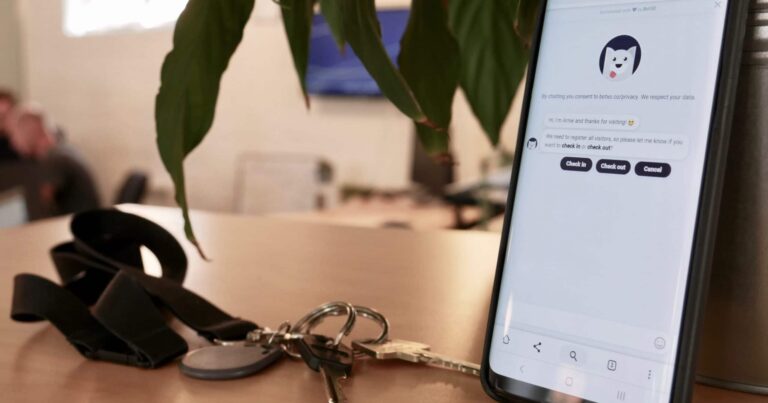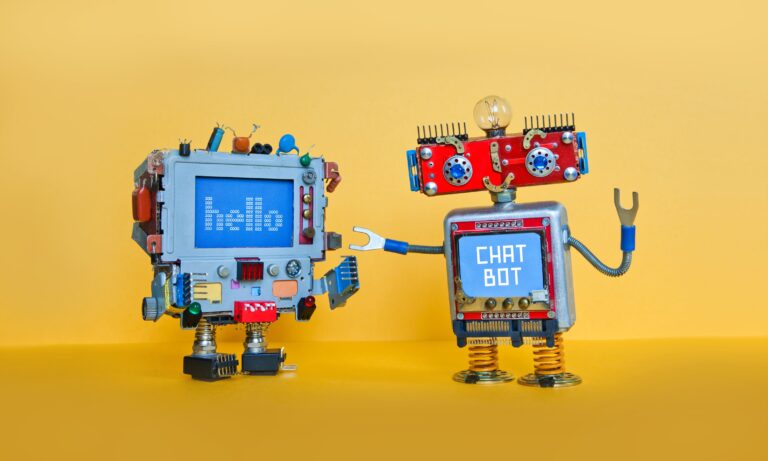NFC Tags – Enhance the Chatbot Experience with NFC

What is NFC?
NFC stands for Near-Field Communication and allows compatible devices to exchange information with a simple tap by way of NFC tags.
In simplest terms, any two objects with NFC tags are able to communicate wirelessly when in (very) close proximity. While it may sound like groundbreaking technology, it is fundamentally more evolutionary than revolutionary.
As a form of wireless communication, NFC can be seen as similar to Wi-Fi, Bluetooth, and, most notably, RFID.
However, the significantly closer proximity required by NFC tags is often seen as a security advantage as it minimizes the odds of accidental interaction. The devices only interact when intended.

NFC is also occasionally compared to QR codes, which are often seen on printed and digital advertisements for users to scan. However, NFC has several advantages that make it stand out.
An NFC reader is embedded in most latest generation Android phones, where there is no need to open a specific application to initiate the interaction. For iPhone, an NFC tag reader will depend on the generation of iPhone and the software you are running.
In this blog post, we will cover the characteristics of NFC tags, an NFC tag reader, current uses of NFC, and how NFC can potentially affect the way we use chatbots.
From QR Codes to NFC
QR codes used to have one notable advantage: market compatibility. A significantly larger number of smartphones were able to scan QR codes compared to NFC.
However, in recent years, we have witnessed an increase in uses for NFC tags as NFC usage grows. Modern smartphones now encompass an NFC tag reader as standard.
This also means businesses have more incentive to utilize them. As a result, many people take advantage of NFC daily in various settings whether they are aware of it or not.

Current Uses of NFC
As mentioned above, NFC functionality is only activated when the compatible devices are together. In other words, we can describe it as a touch-based interaction.
This is particularly important and one of the main reasons why NFC has taken off in the payment space.
For many, smartphones have replaced credit cards as their preferred payment method. Simply holding a smartphone next to a terminal with an NFC tag reader, you will be asked to confirm payment by authenticating the transaction.

It is also possible to pay using other types of NFC-compatible smart devices, such as watches, which makes the technology even more flexible.
In other words, contactless transactions are secure, immediate, and seamless using an NFC tag reader.
This new payment method is more than just a by-product of NFC tags. Smartphone manufacturers have been pushing for this revolution by introducing digital wallet services such as Apple Pay.
They have slowly expanded to an increasing number of countries since their respective launches, making it more and more common to pay with smart devices.
Creative Uses of NFC Tags
Similar contactless technology currently exists for public transport as well, including cards with built-in NFC tags.
In fact, NFC tags are far from exclusive to smart devices. There are numerous creative uses of NFC – especially in entertainment formats such as video games.
Disney, LEGO, and Nintendo have all adopted NFC tags by producing small products including an NFC tag reader that can interact with game software.
Tapping these products (often an action figure) to a game controller will make those characters appear in the game itself, which adds an ‘real-life’ dimension, breaking the barrier between the physical and digital.

Another of the uses for NFC tags is mobile access control which allows the user to manage locks, issue digital keys and manage NFC tags and cards, directly with a mobile phone.
NFC tags are versatile and can take any shape or form. Even something as thin as a cards can have built-in NFC tags.
This is because NFC tags are miniscule. In addition, they are priced so cheaply that most people have access to them.
Miniscule, cheap, and self-programmable – this is the perfect recipe for users to get inventive. The possibilities of NFC tags are only limited by your own creativity.
You could place an NFC reader on your bedside table and make your phone set the alarm for you. How about automatically sharing your Wi-Fi with a tap so nobody has to ask for the password?
While tech-savvy individuals are already taking advantage of this freedom, we believe an increasing number of people will begin to realize the potential of NFC tags in the coming years.
Adding an NFC Tag to a Chatbot
Directing people to a website is one of the simplest uses for NFC tags. However, combining it with a chatbot that users can interact with can make the experience more fun and engaging.
At Certainly, we have a check-in/check-out system for guests of the BotHouse – our office in Copenhagen. By tapping an NFC tag with their phones, guests are automatically directed to a chatbot we created for this purpose.
The chatbot then asks for their name and company at arrival, and, in the same conversational way, it will register their departure when they leave the building. This all happens by simply inputting a URL to the NFC tags we use.

Using NFC tags in a chatbot can potentially make an even more significant impact. An example could be an event with a large number of people having to register their arrival.
This is usually done with the help of clerks or, in the case of self-check-in, tablets such as iPads. In any case, having attendees stand in a line waiting to be checked in is not ideal.
However, NFC tags and NFC readers would make it possible for guests to access a chatbot by touching their personal phone to the NFC tags. The chatbot can then guide users through the check-in process, significantly reducing waiting time.
The chatbot could also be used throughout the event for inquiries, acting as a guide. In a convention setting, the bot would be able to share information about booth, their locations, when and where to find keynote speeches, and opening hours.
This type of assistance would enhance the experience of the event and make it easier to navigate for every party involved.
By automating part of the tasks of customer support teams, staff members will be free to take on other tasks, which could be especially useful during peak hours or holidays such as Black Friday.

A store with NFC tags on the shelves would allow consumers to instantly have access to a personal shopping assistant even if staff are busy – and thus result in higher customer satisfaction.
The bot would be able to answer general questions regarding product information, location within a store, or even general availability.
It could also help visitors by recommending products based on their wants and needs. 90% of smartphone owners use their devices while in-store, making NFC tags the perfect opportunity to create a physical-digital shopping experience.
Improving User Experience with NFC Tags
Taking care of customer inquiries is extremely important. Visitors who are unable to find their desired products are more likely to leave the store, leading to a lost sale.
Because of this, the technology is especially useful for retail. However, the potential scope for NFC tags and chatbots is much wider.
NFC tags and chatbots also act as a channel of communication. Users can initiate dialogue at any time without the need to search for the contact information of a company – a simple tap will allow access.
From a business perspective, it can be seen as a way to improve relationships with customers.
For companies that already sell physical products, incorporating NFC tags in said products should be reasonably effortless. In doing so, consumers will have a constant communication channel available at any time, which can strengthen brand loyalty in the long run.
The touchpoint does not have to be a one-time occurrence and can instead be utilized long after the purchase.
These are just a few ways NFC tags can change the way we use chatbots. We are looking forward to seeing what businesses come up with going forward.
Article written by Salman Rafique

